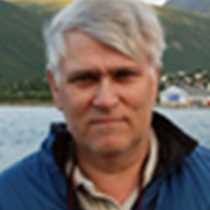Antarctica
The day started with a very successful recovery of the Rope Cam (RC) and later, during the evening recap, we were able for the first time to see pictures from the deep waters of Antarctica. More is to come, as we are slowly learning how to operate this new technology!
What about the rest of the day? After breakfast, we sailed through one of the most scenic parts of the western Peninsula...the Lemaire Channel, named after an explorer to Belgian Congo! The weather really gave us the full polar impression with heavy snowfall and lots of drifting sea ice as we sailed through the narrow channel.
We eventually made it to Peterman Island, “Charcot Land,” which was our southern-most position of the voyage at 65° 10’ S latitude. This was the place where the famous French Antarctic explorer (Jean Baptiste Charcot) over-wintered in the early 20th century. He came south twice, first with the ship Français in 1904/05 and later with the Pourquoi-Pas? in 1908/09. We made a landing at his 1908/09 site and were able to encounter a new penguin species: the Adélie Penguin. We also met up with the OCEANITES summer scientific camp and the scientists gave us an insightful talk about their important work.
The afternoon, still in heavy snowfall, was spent at the former British base (“Base A”) erected during World War II under the secret name Operation Tabarin in 1943. Port Lockroy has been made in to a museum and it is really a trip back into the mid 1950s. It is not only a museum, but also was an opportunity for shopping, as they have stickers, T-shirts, patches, books, etc., for sale. In addition, we made a visit to the nearby Goudier Island, which houses the sad remains of the intense whaling era in these waters. Many large whale bones can be seen at the beach and tons of them lay below the surface where our diving team easily found them. Whaling in Antarctic waters is a sad story, but is also a tale about heroic men fighting severe conditions to make a living. After dinner, the snowfall slowly gave up as we sailed out into waters near Anvers Island and through the very scenic Neumeyer Channel. Another busy day is soon to end!
The day started with a very successful recovery of the Rope Cam (RC) and later, during the evening recap, we were able for the first time to see pictures from the deep waters of Antarctica. More is to come, as we are slowly learning how to operate this new technology!
What about the rest of the day? After breakfast, we sailed through one of the most scenic parts of the western Peninsula...the Lemaire Channel, named after an explorer to Belgian Congo! The weather really gave us the full polar impression with heavy snowfall and lots of drifting sea ice as we sailed through the narrow channel.
We eventually made it to Peterman Island, “Charcot Land,” which was our southern-most position of the voyage at 65° 10’ S latitude. This was the place where the famous French Antarctic explorer (Jean Baptiste Charcot) over-wintered in the early 20th century. He came south twice, first with the ship Français in 1904/05 and later with the Pourquoi-Pas? in 1908/09. We made a landing at his 1908/09 site and were able to encounter a new penguin species: the Adélie Penguin. We also met up with the OCEANITES summer scientific camp and the scientists gave us an insightful talk about their important work.
The afternoon, still in heavy snowfall, was spent at the former British base (“Base A”) erected during World War II under the secret name Operation Tabarin in 1943. Port Lockroy has been made in to a museum and it is really a trip back into the mid 1950s. It is not only a museum, but also was an opportunity for shopping, as they have stickers, T-shirts, patches, books, etc., for sale. In addition, we made a visit to the nearby Goudier Island, which houses the sad remains of the intense whaling era in these waters. Many large whale bones can be seen at the beach and tons of them lay below the surface where our diving team easily found them. Whaling in Antarctic waters is a sad story, but is also a tale about heroic men fighting severe conditions to make a living. After dinner, the snowfall slowly gave up as we sailed out into waters near Anvers Island and through the very scenic Neumeyer Channel. Another busy day is soon to end!




